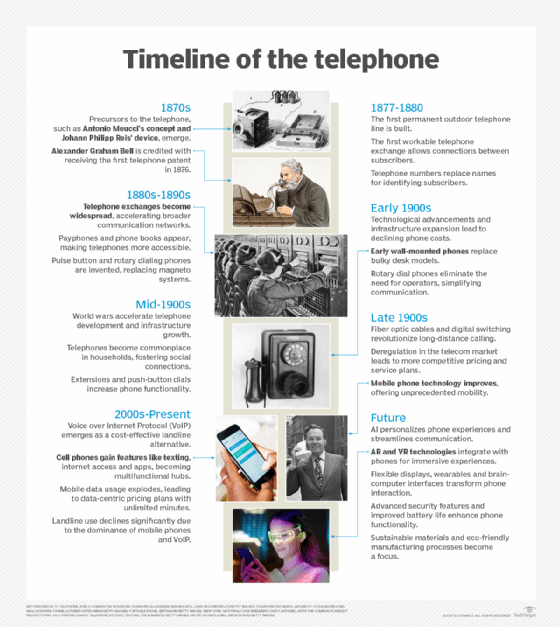
Getty Images/iStockphoto
The history of telephones explained
The telephone, once a marvel for the rich, became a household necessity. Now, mobile phones and web calls have relegated landlines to near-forgotten relics.
Imagine a world without instant communication, when hand-written letters carried news and gossip, but even the fastest horse couldn't deliver a response in less than a few days at best. The late 19th century ushered in a revolution that forever altered how we connect -- the invention of the telephone.
While Alexander Graham Bell received the first telephone patent in 1876, credit isn't his alone. Visionaries like Antonio Meucci and Johann Philipp Reis experimented with transmitting speech electrically. Their tireless efforts paved the way for Bell's groundbreaking invention that transformed the communication landscape.
Early telephones were a far cry from the sleek mobile devices in people's pockets today. Bulky and often desk-mounted, they were a status symbol for the wealthy. Connections were limited to major cities. As technology advanced and infrastructure expanded, telephones became more affordable and accessible.
For most of the 20th century, landline phones were the cornerstone of communication, the lifeline connecting families and businesses across vast distances. Cell phones offer unparalleled mobility, including a growing list of features beyond voice calls. Another technological innovation, voice over Internet Protocol (VoIP), offers a cost-effective alternative, allowing users to make calls over the internet.
These combined forces have eroded the landline's relevance from an indispensable fixture to an afterthought, a testament to the relentless pace of technological progress.
Development of the telephone
The invention of the telephone wasn't a single Eureka moment, but rather the culmination of works by various inventors -- from Meucci's early sketches and Reis' precursor that transmitted simple tones to Bell's eventual patent.
The driving force behind the telephone's development was the desire to transmit speech over long distances, much as the telegraph revolutionized transmitting written messages. Bell was particularly focused on finding a way to send multiple telegraph signals simultaneously, ultimately leading him to invent the telephone.
Commercial telephone use began in North American cities, such as Boston, New York and Toronto. Bell Telephone Company, later known simply as Bell Telephone, spearheaded the effort in the late 1870s. These early phone systems relied on a network of wires connecting subscribers directly to a central exchange. Operators at the exchange manually connected callers. While the telephone's potential for communication was undeniable, its initial high cost and limited reach excluded all but the wealthy at first.
While exact pricing is difficult to find, the cost of having a phone in the 1880s in Ithaca, N.Y., was $3 a month. Other estimates put monthly rates somewhere between $20 and $40. While that might seem manageable, inflation means that monthly cost is $500 to $1,000 in today's dollars. To provide further context, the average yearly income for a worker in the United States around 1870 was $500, making the upfront cost of the phone a barrier, even before adding ongoing service charges. Technological advancements eventually reduced costs, starting the telephone's journey to household staple.

20th-century developments
Telephones gradually became commonplace in homes throughout the early 20th century, transforming from a curiosity of the elite to a necessity for many.
Early days (late 1870s - early 1900s)
Stringent infrastructure limitations meant phone lines were scarce and primarily concentrated in major cities. The service was also prohibitively expensive, restricting use mainly to businesses and the very affluent.
The first telephones were conversation starters not just because of their novelty but also due to their bulk and prominence on any desk. Additionally, these early phones relied on a magneto system. The user cranked a handle to generate electricity, alerting an operator at a central exchange. This operator then manually connected the user to their desired party, adding complexity to the communication process.
Shift toward commonplace (early 1900s - mid-1900s)
As the 20th century started, technological advancements and the growing reach of telephone companies led to decreased service charges and phone prices. This, coupled with expanding infrastructure that brought phone lines to more areas, made telephone ownership realistic for the middle class.
Early wall-mounted phones replaced desktop models, offering a more convenient solution for integrating telephones into homes. The invention of rotary dial phones enabled users to directly connect calls themselves by dialing a series of numbers, eliminating the need for operators and streamlining the communication process.
The start of widespread adoption (mid-1900s - late 1900s)
Both world wars played a significant role in accelerating telephone adoption. The critical need for wartime communication spurred infrastructure development and innovation advancements, leading to more affordable and reliable phone service for the public after World War II.
Beyond practicality, telephones offered a social connection unmatched by letters or telegrams. Real-time conversations with physically distant family, friends and businesses fostered closeness and immediacy. Its revolutionary social impact and growing affordability cemented the telephone's place as a fundamental household appliance.
By the mid-20th century, telephones were a common sight in many households. Early rotary dial models gave way to colorful options and the introduction of extensions within a single home, creating a more versatile communication system. Push-button phones, invented later in the century, offered a more user-friendly experience than rotary dials. However, compared to today's smartphones, these phones were limited to voice calls only.
The evolution from analog to digital
In the early days of landlines, long-distance calls relied on analog infrastructure. Routing calls through long-distance carriers and switches added complexity and cost. Imagine a quiet, single-lane highway for local calls versus a congested, multi-lane highway with tolls for long-distance travel. This legacy system justified the per-minute charges for calls that ventured beyond a local network.
The development of fiber optic cables and digital switching in the late 20th century transformed those congested highways into efficient information superhighways. Digital signals traveled faster with less signal degradation, significantly reducing the cost of long-distance calls. The extra leg of the journey became almost negligible, making per-minute charges unnecessary.
The telecommunications market became more competitive with the entry of new players and deregulation in the 1990s. Phone companies offered customizable, bundled packages with unlimited minutes to attract customers. These plans gave customers both freedom and predictability in their calling habits and helped phone companies retain customers.
Pricing changes didn't occur only with landlines. Early cell phone networks had limited capacity, and peak hours meant dropped calls. To manage the congestion, carriers implemented peak-hour charges to discourage excessive use during the busier morning and evening periods.
But cellphone technology improved, network capacity expanded, more cellphone towers were built and the overall network architecture became more efficient. With improved infrastructure, flat-rate plans with unlimited minutes became attractive to providers and users seeking predictability in service and cost.
With the rise of smartphones, internet browsing, streaming services and apps became the primary drivers of network traffic and mobile data usage. Voice calls became a secondary concern for carriers eyeing data usage and pricing. Unlimited minutes attracted customers, with data caps and tiered pricing the new norm. In essence, carriers offered limitless calling and competed on data pricing.
21st-century developments
VoIP and the rise of cell phones have significantly reshaped the communication landscape, dramatically reducing traditional landline use. Landlines, for all their usefulness, chain users to a physical location. Cell phones let people make and receive calls from almost anywhere. This flexibility attracts potential users, particularly younger users who've grown up in a world of constant connectivity.
Cell phones deliver text messaging, email access and the internet, with its suite of apps and access to social media -- all from a single device. This convenience further eroded the appeal of landlines.
Although cell phone plans were expensive in their early days, costs became more competitive. Affordable calling packages, prepaid options and bundled services with mobile data made cell phones accessible to a broader audience. For many, a cell phone plan's convenience and bundled features outweighed the lower cost of landline service.
Meanwhile, VoIP emerged as a compelling, cost-conscious alternative to landlines for homeowners and businesses alike. VoIP leverages existing internet infrastructure to transmit voice calls, bypassing the traditional phone network. This means significantly lower rates, especially for long-distance calls, often a pain point for landline users.
VoIP systems aren't just about cheaper phone calls. Their features include video conferencing, voicemail transcription, call forwarding and voicemail-to-email integration. Basic landline services can't compare to VoIP's versatility. For example, businesses improve collaboration and streamline workflows with features like video conferencing, while voicemail transcription is a convenient way to manage messages.
Furthermore, VoIP systems are inherently flexible and scalable, unlike traditional landline setups that require additional physical lines for expansion. This scalability makes VoIP attractive to startups and companies with fluctuating staffing needs.
Once a necessity in every home, landlines have become a secondary option. However, it's important to acknowledge that landlines still offer some advantages, such as reliability during internet outages and potentially lower costs for basic phone service in some areas.
Telephones of the future
Future devices might seamlessly integrate with their owners' lives, anticipate their needs and transform how people connect with the world.
AI will prove an indispensable partner. AI assistants understand a person's habits and preferences. For example, Google Assistant filters incoming calls and messages and makes appointments for local services, such as haircuts, massages and doctor's appointments. These features are always changing and personalizing the phone experience to an unprecedented degree.
The boundaries between the physical and digital realms will blur further with the integration of augmented reality (AR) and virtual reality (VR) technologies. For example, retail websites -- such as Amazon and Wayfair -- permit a phone's camera to overlay virtual furniture onto a customer's living room in real time, letting the customer experiment with different layouts before buying. VR integration opens doors to immersive communication experiences, such as attending virtual meetings or concerts from anywhere in the world. This promotes a heightened sense of presence and connection despite physical distance.
Even the way people interact with phones has changed. Some flexible phones unfold from a pocket-sized rectangle into a tablet-sized screen, perfect for watching videos or gaming. Wearable technology includes phone integration through bracelets, glasses or clothing, which can measure a person's biometrics. Discreet earpieces eliminate the need for users to hold the phone, freeing their hands for other tasks.
While still in their early stages of development, brain-computer interfaces might revolutionize how people interact with their phones entirely. For example, people could control a phone with their thoughts or initiate calls and compose messages through a brain-computer link, eliminating buttons and touchscreens.
Security features on future phones might become even more sophisticated and seamless. Fingerprint and facial recognition are already commonplace, but scanners, voice recognition or vein mapping technology provide more enhanced security.
One of the biggest frustrations for phone users today is battery life. They hope future phones will last for days on a single charge. Additionally, a growing focus on sustainability and eco-friendly manufacturing processes will reduce the environmental impact of phone production, including the rising use of recycled materials in sustainable smartphone construction.
Kaitlin Herbert is a content writer and former managing editor for the Learning Content team. She writes definitions and features.








